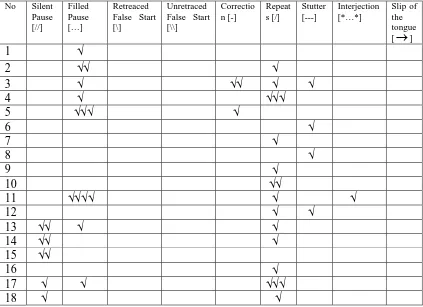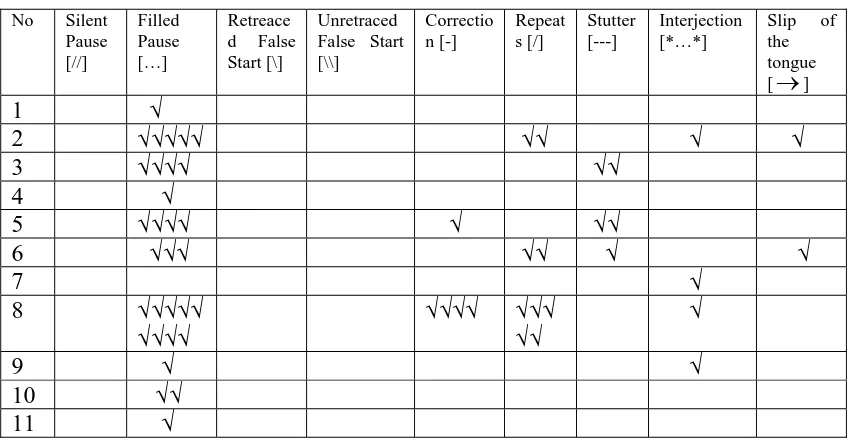Informasi Dokumen
- Penulis:
- Ivan C H Lumbantobing
- Pengajar:
- Prof. Syaiffudin, M. A, Ph. D
- Drs. Swesana Lubis, M. Hum
- Drs. Yulianus Harefa, M. Ed TESOL
- Dr. Syahron Lubis, M. A
- Dr. Eddy Setia, M. Ed TESP
- Dra. Nurcahaya Bangun, M. Si
- Sekolah: University of Sumatera Utara
- Mata Pelajaran: English Department
- Topik: Speech Errors in Interviews of Metro TV’S Indonesia This Morning News Program
- Tipe: thesis
- Tahun: 2009
- Kota: Medan
Ringkasan Dokumen
I. INTRODUCTION
This section introduces the topic of speech errors in interviews, specifically focusing on the INDONESIA THIS MORNING news program on Metro TV. It outlines the significance of studying speech errors, as they can reveal underlying issues in communication, particularly in high-stakes environments like news broadcasting. Understanding these errors can enhance the performance of reporters and guests, ultimately improving the quality of news delivery. The section also establishes the relevance of this analysis to educational objectives, particularly in linguistics and communication studies, emphasizing the need for effective speech in media.
1.1 Background of Analysis
The background section discusses the importance of speech in communication, particularly in television interviews. It highlights how speech errors can occur due to various factors such as anxiety, lack of preparation, or cognitive overload. The relevance of this analysis extends to training programs for journalists and media professionals, illustrating how understanding speech errors can lead to better communication strategies and improved audience engagement.
1.2 Scope of Analysis
This subsection delineates the specific focus of the research, which is the analysis of speech errors made by reporters and guests during interviews on the INDONESIA THIS MORNING program. It emphasizes the need for rigorous analysis in understanding the types of errors that occur, their frequency, and the contexts in which they arise. This scope is crucial for developing targeted educational interventions for improving speech delivery in media.
1.3 Problems of Analysis
The problems of analysis section identifies key questions that guide the research, including the types of speech errors, their frequency, and the factors contributing to these errors. Addressing these problems is essential for developing effective strategies to minimize speech errors, which is a significant educational outcome for both media professionals and students in communication studies.
1.4 Objective of Analysis
This subsection outlines the objectives of the analysis, which include identifying and categorizing speech errors, understanding their frequency, and exploring the factors that contribute to their occurrence. These objectives align with educational goals by providing insights that can enhance training programs for journalists and improve communication skills among students.
1.5 Significance of Analysis
The significance section discusses the broader implications of the research findings for media professionals and educators. By understanding speech errors, professionals can improve their communication skills, while educators can develop curricula that address these issues. This section emphasizes the relevance of the analysis to enhancing both theoretical knowledge and practical skills in communication.
1.6 Review of Related Literature
This subsection reviews existing literature on speech errors and their implications in communication. It highlights key theories and studies that inform the current analysis, providing a foundation for understanding the complexities of speech production and the psychological factors that influence it. The review underscores the academic value of the research, linking it to ongoing discussions in psycholinguistics and media studies.
II. AN OVERVIEW OF SPEECH PRODUCTION AND SPEECH ERRORS
This section provides a comprehensive overview of the theoretical framework surrounding speech production and the types of speech errors. It connects linguistic theories with psycholinguistic principles, emphasizing the importance of understanding the cognitive processes involved in speech production. This knowledge is crucial for educators and practitioners in developing effective communication strategies and minimizing errors in high-stakes environments such as news broadcasting.
2.1 The Relationship between Linguistics and Psycholinguistics
This subsection explores the interplay between linguistics and psycholinguistics, highlighting how linguistic structures influence speech production and errors. Understanding this relationship is essential for educators, as it provides insights into how language acquisition and cognitive processes affect communication. This knowledge can inform teaching methods and curricula in language and communication studies.
2.2 Competence and Performance
In this subsection, the concepts of competence and performance are discussed, emphasizing their relevance in understanding speech errors. Competence refers to the underlying knowledge of language, while performance relates to the actual use of language in communication. Recognizing the distinction between these concepts is vital for educators to develop training programs that enhance both theoretical knowledge and practical speaking skills.
2.3 Speech Planning and Execution
This subsection outlines the processes involved in planning and executing speech, emphasizing the cognitive demands placed on speakers. Understanding these processes is critical for educators, as it can inform strategies to help students and professionals manage speech production more effectively, reducing the likelihood of errors during high-pressure situations like live interviews.
2.4 The Classification and Description of Speech Errors
The classification of speech errors is detailed in this subsection, providing a framework for identifying and analyzing different types of errors. This classification is essential for educators and practitioners, as it allows for targeted interventions to minimize specific errors in speech production, ultimately enhancing communication effectiveness in media contexts.
III. RESEARCH METHODOLOGY
This section outlines the research methodology employed in the study, detailing the methods used for data collection and analysis. A clear understanding of the methodology is crucial for academic rigor and for ensuring that the findings are reliable and applicable in educational contexts.
3.1 Research Method
This subsection describes the descriptive research method used to analyze speech errors in interviews. The choice of method is justified by its effectiveness in systematically capturing and describing the phenomena under study, which is essential for informing educational practices in communication.
3.2 The Population and Sample
In this subsection, the population and sample for the study are defined, detailing the selection criteria for interviews analyzed. Understanding the sampling process is critical for evaluating the validity of the findings and their applicability to broader educational contexts.
3.3 Method of Collecting Data
This subsection outlines the data collection methods, including recording and transcribing interviews. Clear documentation of the data collection process is essential for replicability and for ensuring that the findings can be reliably used in educational settings.
3.4 Method of Analyzing Data
The data analysis methods are detailed in this subsection, explaining how speech errors were identified and classified. This systematic approach to data analysis is vital for drawing meaningful conclusions that can inform educational strategies and improve communication skills.
IV. THE ANALYSIS OF SPEECH ERRORS
This section presents the analysis of speech errors identified in the interviews. The findings are crucial for understanding the prevalence and types of speech errors in a real-world context, providing valuable insights for educators and media professionals alike.
4.1 Types of Errors Made by the Reporter and Guest Stars
This subsection provides a detailed analysis of the types of speech errors made during the interviews, categorizing them based on frequency and type. This analysis is essential for identifying common pitfalls in speech production, informing educational interventions aimed at reducing these errors in future broadcasts.
4.2 Reporter and Guest Star’s Factors of Making Errors
In this subsection, the factors contributing to speech errors are explored, including cognitive load, anxiety, and lack of preparation. Understanding these factors is critical for developing targeted training programs that address the specific challenges faced by reporters and guests in high-pressure speaking situations.
4.3 The Tips to Minimize Making Errors
This subsection offers practical tips for minimizing speech errors based on the analysis of the interviews. These recommendations are valuable for educators and media professionals seeking to improve their communication skills and reduce the occurrence of errors in live broadcasts.
V. CONCLUSIONS AND SUGGESTIONS
The final section summarizes the key findings of the research and offers suggestions for future studies and practical applications. This summary is essential for reinforcing the educational objectives of the research and highlighting areas for further exploration.
5.1 Conclusions
This subsection synthesizes the findings of the analysis, reinforcing the importance of understanding speech errors in the context of media communication. The conclusions drawn are vital for informing educational practices and enhancing the effectiveness of communication training programs.
5.2 Suggestions
In this subsection, suggestions for future research and practical applications are provided. These suggestions are important for guiding further exploration into speech errors and their implications for communication education, ensuring that the field continues to evolve and improve.




